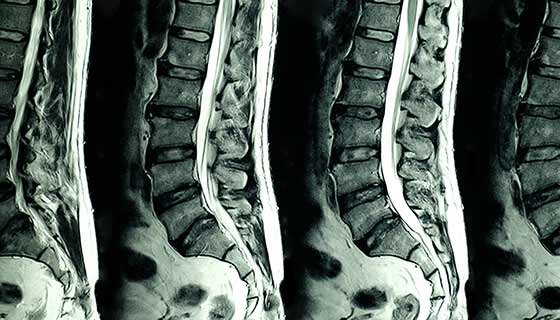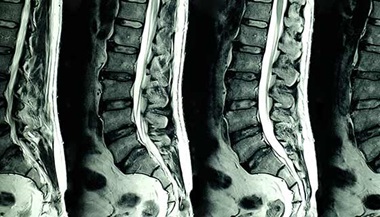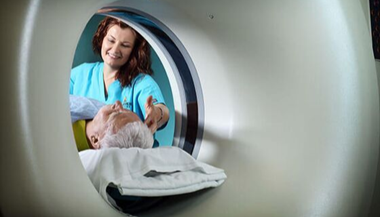Abdominal X-ray
What is an abdominal X-ray?
X-rays use invisible electromagnetic energy beams to make images of the abdomen. X-rays pass through body tissues onto a special film similar to camera film and make a picture. The more solid a structure is, the whiter it looks on the film. Computers and digital media are now more commonly used instead of film. They show pictures of your internal tissues, bones, and organs. Bone and metal show up as white on X-rays.
X-rays of the belly may be done to check the area for causes of abdominal pain. It can also be done to find an object that has been swallowed or to look for a blockage or a hole in the intestine.
Abdominal X-rays may be taken in the following positions:
-
Standing up
-
Lying flat with the picture made from above
-
Standing with the picture made from the front
-
The left side-lying position. This may be used if you can’t stand up.
When two or more of these views are taken, the set of films may be called an obstruction series. This series of X-rays is done to try to locate a site of a suspected blockage in the abdomen or intestine.
Why might I need an abdominal X-ray?
Abdominal X-rays may be used to diagnose causes of abdominal pain. These can include things such as masses, openings in the intestine, kidney stones, or blockages. Abdominal X-rays may be done before other tests that look at the gastrointestinal (GI) tract or urinary tract. These include an abdominal CT scan and renal or kidney tests.
Basic information regarding the size, shape, and position of abdominal organs can be seen with abdominal X-rays. Stones in the gallbladder, kidneys, or ureters may be seen. Calcification of the aorta may also be seen with an abdominal X-ray. There may be other reasons for your healthcare provider to recommend an abdominal X-ray. Talk with your healthcare provider about the reason for your abdominal X-ray.
What are the risks of an abdominal X-ray?
You may want to ask your healthcare provider about the amount of radiation used during the procedure. Also ask about the risks related to your particular situation. It's a good idea to keep a record of your radiation exposure, such as previous X-rays and other scans, so that you can tell your provider. Risks linked to radiation exposure may be from the number of X-ray exams or treatments over time.
If you are pregnant or think you may be pregnant, tell your healthcare provider. Being exposed to radiation during pregnancy may lead to birth defects.
There may be other risks depending on your specific medical problem. Discuss any concerns with your healthcare provider prior to the procedure.
Recent barium X-rays of the abdomen or belly may affect the accuracy of an abdominal X-ray.
How do I get ready for an abdominal X-ray?
-
Your healthcare provider will explain the procedure to you and give you a chance to ask any questions about the procedure.
-
Generally, you don't need to do anything to get ready for the test.
-
Tell your healthcare provider and the radiologic technologist if you are pregnant or think you may be pregnant.
-
Tell your healthcare provider if you've taken a medicine that contains bismuth in the past 4 days. Medicines that have bismuth may get in the way of the testing procedures.
-
Your healthcare provider may ask for other specific preparation.
What happens during an abdominal X-ray?
Abdominal X-rays may be done on an outpatient basis or as part of your hospital stay. Tests and procedures may vary depending on your condition.
Generally, abdominal X-rays follow this process:
-
You will be asked to remove any clothing, jewelry, or other objects that might get in the way during the procedure.
-
If you are asked to remove clothing, you will be given a gown to wear.
-
You will be positioned in a way that carefully places the part of the abdomen or belly to be X-rayed between the X-ray machine and the film. You may be asked to stand up, lie flat on a table, or lie on your side on a table, depending on the X-ray view your healthcare provider has asked for. You may have X-rays taken from more than one position.
-
Body parts not being imaged may be covered with a lead apron or shield to limit exposure to the X-rays.
-
Once you are positioned, you will be asked to hold still for a few moments while the X-ray is taken. You may be asked to hold your breath at various times during the X-ray. It's very important to stay completely still while the X-ray is taken. Any movement may alter the image and may even require another X-ray to be done.
-
The X-ray beam is then focused on the area to be examined.
-
The radiologic technologist steps behind a protective window while the image is taken.
While the X-ray procedure itself causes no pain, moving the body part being examined may cause some discomfort or pain, particularly if you’ve recently had surgery or been injured. The radiologic technologist will use all possible comfort measures and complete the procedure as quickly as possible to minimize any discomfort or pain.
What happens after an abdominal X-ray?
Generally, there is no special type of care after abdominal X-rays. Your healthcare provider may give you other instructions, depending on your situation.
Next steps
Before you agree to the test or the procedure, make sure you know:
-
The name of the test or procedure
-
The reason you are having the test or procedure
-
What results to expect and what they mean
-
The risks and benefits of the test or procedure
-
What the possible side effects or complications are
-
When and where you are to have the test or procedure
-
Who will do the test or procedure and what that person’s qualifications are
-
What would happen if you did not have the test or procedure
-
Any alternative tests or procedures to think about
-
When and how you will get the results
-
Who to call after the test or procedure if you have questions or problems
-
How much you will have to pay for the test or procedure





